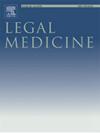开发用于同时鉴定唾液和精液的两步逆转录液滴数字 PCR (RT-ddPCR)
IF 1.3
4区 医学
Q3 MEDICINE, LEGAL
引用次数: 0
摘要
确定体液类型对于重建犯罪现场和提高专家证词的可靠性至关重要。通过反转录定量 PCR(RT-qPCR)分析信使 RNA(mRNA)已被用于法医遗传学,特别是体液鉴定。这是一种比较目标基因和参照基因 Ct 值的相对定量方法。因此,该方法不适合确定目标基因的确切拷贝数。为了解决这一局限性,本研究使用两步逆转录液滴数字 PCR(RT-ddPCR)进行了体液特异性 mRNA 分析,这种方法能够进行绝对定量。我们发现,RT-ddPCR 的准确性和灵敏度足以检测到低至 1.5 个拷贝/μl 的互补 DNA (cDNA),因此适合应用于病例样本。它对体液的特异性也很高,不会出现非特异性扩增。此外,比例从 1:50 到 50:1 的唾液-精液混合物也能成功鉴定。在比较 RT-qPCR 和 RT-ddPCR 的结果时,由于 RT-qPCR 的 Ct 值较高,有些样本难以解释。然而,当使用 RT-ddPCR 对相同样本进行分析时,唾液和精液被明显地识别出来。因此,RT-ddPCR 适用于 DNA 含量较低的混合样本(如性侵犯案件),而使用 RT-qPCR 时往往会导致结果模糊不清。其他体液(如阴道分泌物和月经血)也可以通过加入额外的标记物来进行鉴定。这项研究证明了 RT-ddPCR 在法医学领域的应用潜力。本文章由计算机程序翻译,如有差异,请以英文原文为准。
Development of two step reverse transcription droplet digital PCR (RT-ddPCR) for simultaneous identification of saliva and semen
Determination of the type of body fluids is essential for crime scene reconstruction and for improving the reliability of expert testimonies. Messenger RNA (mRNA) analysis by reverse transcription quantitative PCR (RT-qPCR) has been used in forensic genetics, particularly for body fluid identification. It is a relative quantification method that compares the Ct values of target and reference gene. Thus, the method is unsuitable for determining exact copy numbers of the target gene. To address this limitation, this study performed body fluid-specific mRNA analysis using two-step reverse transcription droplet digital PCR (RT-ddPCR), which is capable of absolute quantification. We found that RT-ddPCR was accurate and sensitive enough to detect as little as 1.5 copies/μl of complementary DNA (cDNA), making it suitable for application using casework samples. It was also highly specific for body fluids, as non-specific amplification did not occur. In addition, saliva-semen mixtures with ratios ranging from 1:50 to 50:1 were successfully identified. When comparing the results of RT-qPCR and RT-ddPCR, some samples were difficult to interpret because of the high Ct values of RT-qPCR. However, when the same samples were analyzed using RT-ddPCR, saliva and semen were distinctly identified. Thus, RT-ddPCR is useful for mixed samples (e.g., in sexual assault cases) with low amounts of DNA, which often leads to ambiguous results when using RT-qPCR. Other body fluids (e.g., vaginal fluid and menstrual blood) can also be identified by including additional markers. This study demonstrates the potential of RT-ddPCR for applications in forensic science.
求助全文
通过发布文献求助,成功后即可免费获取论文全文。
去求助
来源期刊

Legal Medicine
Nursing-Issues, Ethics and Legal Aspects
CiteScore
2.80
自引率
6.70%
发文量
119
审稿时长
7.9 weeks
期刊介绍:
Legal Medicine provides an international forum for the publication of original articles, reviews and correspondence on subjects that cover practical and theoretical areas of interest relating to the wide range of legal medicine.
Subjects covered include forensic pathology, toxicology, odontology, anthropology, criminalistics, immunochemistry, hemogenetics and forensic aspects of biological science with emphasis on DNA analysis and molecular biology. Submissions dealing with medicolegal problems such as malpractice, insurance, child abuse or ethics in medical practice are also acceptable.
 求助内容:
求助内容: 应助结果提醒方式:
应助结果提醒方式:


